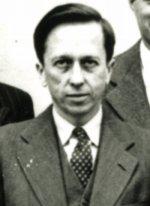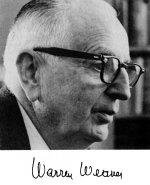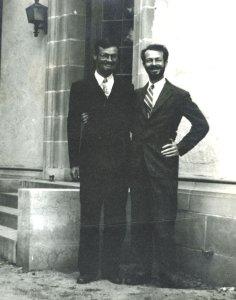
[Ed. Note: This year marks the 75th anniversary of Linus Pauling's publication of his landmark text, The Nature of the Chemical Bond. For the next six weeks we will take a detailed look at the creation, release and impact of a book that changed the scientific world.]
Linus Pauling’s The Nature of the Chemical Bond, first published in 1939, was the product of over two decades of diligence, sacrifice, and collaboration among a broad range of actors that included Pauling’s family, research assistants, professional colleagues and a variety of institutions. Pauling’s prefatory remarks to the book - “For a long time I have been planning to write a book on the structure of molecules and crystals and the nature of the chemical bond” - give an indication of the extent to which this was a long-term objective for Pauling, despite his being only 38 years old.
Looking back at his process, Pauling’s application for a grant from the Carnegie Institute in February 1932 provides a more detailed affirmation of his ambitions. In it, Pauling relayed how his undergraduate research in crystal structures at Oregon Agricultural College between 1917 and 1922 had laid the foundation for his current work by bringing him into contact with contemporary questions in structural chemistry. As a graduate student at Caltech, Pauling began to search for answers to those questions in the newly developing field of quantum mechanics.
In pursuit of those answers, Pauling and his wife Ava Helen, with the support of a Guggenheim Fellowship, left their one-year-old son, Linus Jr., with Ava Helen’s mother in Portland and traveled to Europe in 1926 to study quantum mechanics at its source. There, Pauling deepened his understanding and immersed himself even more by beginning to apply the new physics directly to chemical bonding.

J. Holmes Sturdivant
Upon returning to Caltech in 1927, Pauling began to seek funding so he could continue what he had begun. Let down by the National Research Fund, Pauling supported his work with funding from Caltech and the National Research Council, money which allowed him to hire a full time assistant, J. Holmes Sturdivant, who focused on x-ray crystallography and continued to work with Pauling for many years. Pauling also brought aboard Boris Podolsky for nine months to assist him with the more detailed technical components of connecting quantum mechanics to chemical bonding.
In 1932 Pauling expressed a hope that, with help from the Carnegie Institute, he could expand his work by funding more assistants and purchasing equipment like an “electric calculating machine,” a “specialized ionization spectrometer,” and a microphotometer. The Carnegie Institute was not interested. Luckily for Pauling, the Rockefeller Foundation came through with a general grant of $20,000 per year over two years, to be split between the physics and chemistry departments at Caltech. This allowed Pauling to keep Sturdivant on staff while adding George Wheland, Jack Sherman, and E. Bright Wilson, Jr. to his research team.
This scramble to secure funding and bring new people into the lab came amidst the publication of Pauling’s first four “Nature of the Chemical Bond” articles for the Journal of the American Chemical Society, proof positive that Pauling’s work was bearing fruit. Once the funding was secured and Sherman and Wheland began producing results, Pauling wrote – with Sherman and Wheland as co-authors - three more “Nature of the Chemical Bond” articles the following year, published in the newly established Journal of Chemical Physics. Wheland also worked with Pauling on a monograph discussing the application of quantum mechanics to organic molecules. Wheland finished his part of the book by 1937, but Pauling never got around to his portion: his desire to write a book length treatment of chemical bonds began, more and more, to take center stage.

Warren Weaver
In order to keep the funding coming in through the lean years of the Great Depression, Pauling was compelled to follow the lead of his patrons, the Rockefeller Foundation. Warren Weaver, Director of Natural Sciences for the foundation, told Pauling in December 1933 that the organization was “operating under severe restrictions” and that funding would go to projects “concentrated upon certain fields of fundamental quantitative biology.” That Pauling’s work had “developed to the point where it promises applications to the study of chlorophyll, haemoglobin and other substances of basic biological importance” was key to his potential receipt of continued dollars.
The commitment of Caltech’s chemistry department to continue pursuing the line of research suggested by Weaver helped Pauling to secure funding for the following year. A three-year commitment came after that, providing the Caltech group with a reliable source of support into 1938. Pauling thanked Weaver in February of that year for his direction, writing,
I am of course aware of the fact that our plans for organic chemistry not only have been developed with the aid of your continued advice but also are based on your initial suggestion and encouragement; and I can forsee that I shall be indebted to you also for the opportunity of carrying out on my own scientific work in the future to as great an extent as I have been during the past six years.
Secure funding allowed Pauling to maintain a research group consisting of graduate students and post-doctoral fellows. In his preface to The Nature of the Chemical Bond, Pauling expressed his gratitude to several of these individuals, including Sherman and Sturdivant. Another, Sidney Weinbaum, earned his doctorate under Pauling and continued on afterwards, helping Pauling with quantum mechanical calculations and molecular structures.
Fred Stitt worked as research fellow with Pauling and assisted him in teaching his graduate course on the applications of quantum mechanics to chemistry – an exercise, no doubt, that helped to shape Pauling’s own thoughts on the subject, crystallizing them in preparation for the book.

Charles Coryell and Linus Pauling, 1935.
Charles Coryell worked as a research fellow at the Caltech lab with Pauling on the topic of magnetic susceptibilities, which were central to investigating chemical bonds. (Coryell also later helped Pauling to construct a magnet for the Caltech labs, based on one already in place at Cornell.)
Edwin H. Buchman, according to a 1985 oral history interview, was self-supporting due to royalties from his synthesis of vitamin B1. Buchman told Pauling in May 1937 that he would assist Pauling “on any problem in which an organic chemist could be useful and for which extra space could be had.”
Once assembled, Pauling’s team helped him to refine his understanding of chemical structures and bonding as the time approached when he could produce a book-length treatment on the subject.
